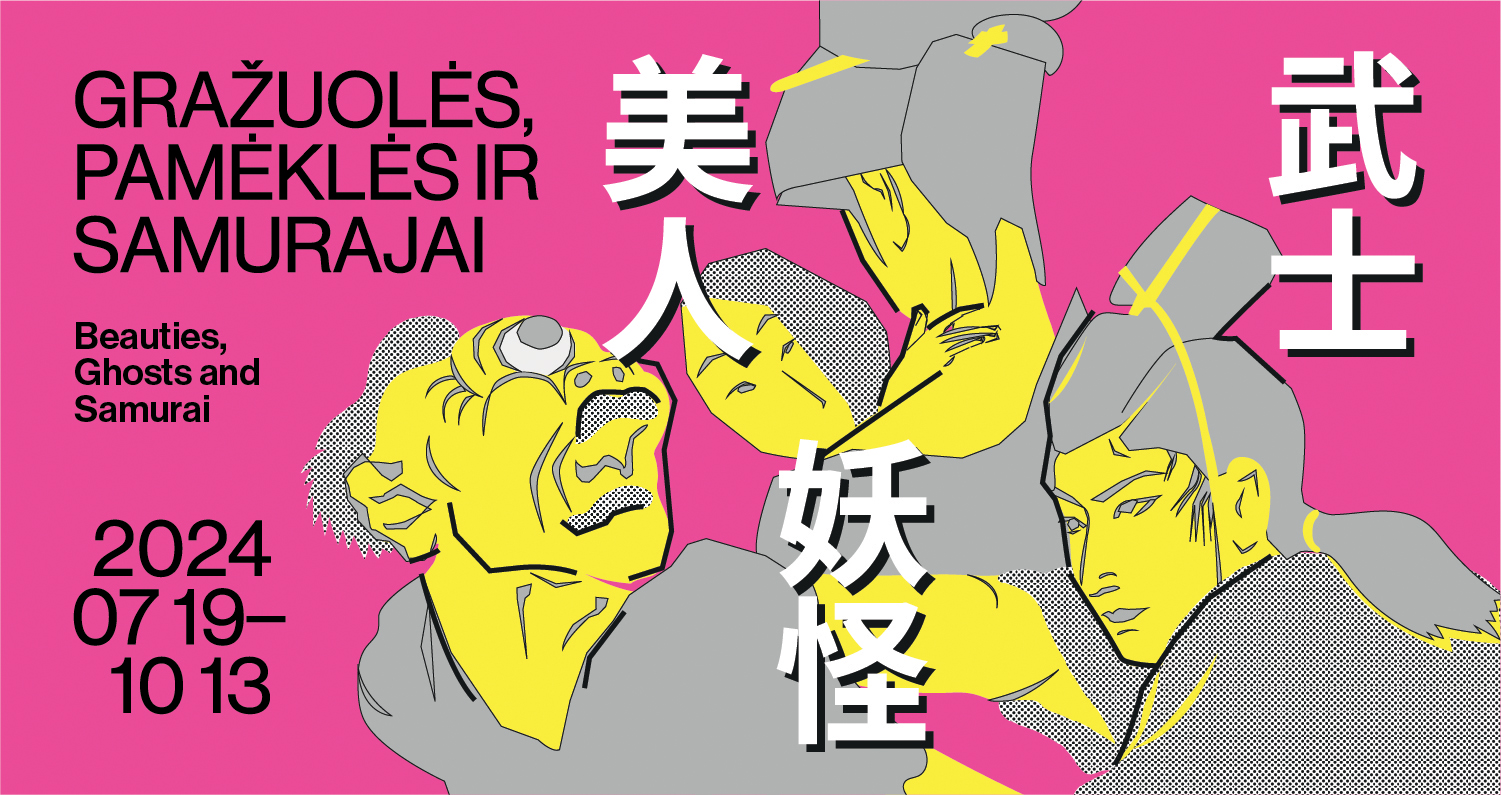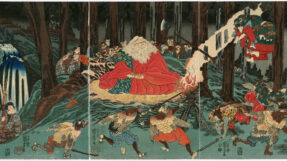Beauties, Ghosts and Samurai. Japan's pop culture tradition from Edo period ukiyo-e to 20th-21st-century manga, anime and sūpā furatto
19 July - 13 October 2024
When does culture become truly popular? When it ceases to be the exclusive domain of the nobility and the wealthy, and spreads among the middle class and other less politically empowered social classes. A prime example of this phenomenon was in 17th century Edo (modern-day Tokyo), where a strictly hierarchical society led to the establishment of a leisure and entertainment space accessible to the townspeople (chōnin[町人])-the Yoshiwara district.
Yoshiwara was the birthplace of Japanese popular culture, which enjoyed enormous success far beyond Japan’s borders. This cultural hub fostered kabuki theatre, the art of ikebana flower arrangement, haikai poetry, and the colorful woodblock prints ofukiyo-e. These prints, once considered lowly, cost as much as a meal at a city eatery and were sometimes used to wrap precious porcelain and ivory. This was the first time in world history that a politically uninfluential group of people, unable to travel abroad, created high-level art for their own needs rather than for the upper classes (rulers, aristocrats, clergy).
Besides graphic prints, ukiyo-e masters created hikifuda advertising posters and giga cartoons, which crystallized into manga in the late 19th century, and from manga in the 20th century into the world-famous anime of today. While ukiyo-e masterpieces have long since ceased to be considered lowly prints and have made their way into galleries and museums, manga and anime have, until recently, not been considered ‘art’.
This historical-panoramic exhibition is one of the few attempts (and the first in Lithuania) to bring together and reveal the interconnectedness of what has often been separated, even today: ukiyo-e prints, historical giga cartoons, eroticshungabooklets, commercial hikifuda posters, pre-war and post-war manga comics, children’s gamemenkocards, posters for anime movies and computer games, promotional videos for the famous cosmetics company Shiseido, an animated historical kabuki theatre curtain, excerpts from famous anime films, and works of Japanese contemporary art (including thesūpāfurattomovement)-from painting and printmaking to photography, animation, and sculpture-that reflect (and at times ironise and question) all of the above.
The works of more than seventy artists are grouped into three categories: images of beauties (bijin), frightening or humorous tales of spirits and ghosts (yōkai) and heroic feats of samurai (bushi, samurai). The exhibition’s inventive architecture, along with its sound and lighting design, create an allusion to Japanese urban space. In present-day Tokyo, the world’s largest city, the structure of popular culture remains largely unchanged: the desire to charm and seduce, to frighten and amuse, to inspire awe with bravery and ferocity, persists in modern romantic and erotic dramas, horror films, comedies, thrillers, action films, and games. Not to mention the contemporary art that reflects, ironises, and often questions all of the above.
Participants:
Ukiyo-e: Suzuki Harunobu, Kitagawa Utamaro, Katsushika Hokusai, Utagawa Toyokuni, Utagawa Kunisada (Utagawa Toyokuni III), Utagawa Kunisada II, Utagawa Toyohiro, Utagawa Kuniyoshi, Utagawa Yoshitora, Utagawa Yoshimori, Keisai Eisen (Shigeharu Eisen), Hiroshige Utagawa (Hiroshige Ando), Torii Kiyonaga, Kikugawa Eizan, Katsukawa Shunshō, Tsukioka Yoshitoshi, Tsukioka Kōgyo, Ogata Gekkō, Toyohara Kunichika, Toyohara Chikanobu, Miyagawa Shuntei, Totoya Hokkei, Kitagawa Tsukimaro, Isoda Kôryûsai (Isoda Masakatsu), Eishōsai Chōki (Momokawa Chōki), Watanabe Nobukazu (Yōsai Nobukazu), Migita Toshihide, Eishi Hosoda (Chobunsai).
Giga, manga, posters: Kawanabe Kyōsai, Osamu Tezuka, Kazuo Kamimura, Shigeru Mizuki, Kinkichirō Honda, Tekisui Ishii, Mitsuteru Yokoyama, Hisashi Sekiya, Asakazu Arikawa, Sōji Ushio, Kenjirō Ishikawa, Seiichi Hayashi, Suiho Yonai, Hiroshi Hirata, Naotoshi Kago, Tomoyo Jinbo, Hidetsune Kobayashi, Arumi Tokita, Kazuichi Hanawa, Chōshun Fuse, Arina Tanemura, Katsuyuki Shinohara.
Anime: Osamu Tezuka, Kenji Nakamura, Katsuhiro Otomo, Shinichirō Watanabe.
Contemporary art: Makoto Aida, Nobuyoshi Araki, Mari Katayama, Akino Kondoh, Mr.,Takashi Murakami, Toshio Saeki, Namonaki Sanemasa, Aya Takano, Keiichi Tanaami, Yuichiro Ukai, Kazuki Umezawa.
Curator: Dr. Arūnas Gelūnas
Chief Consultant: Professor Tetsuya Ozaki
Architects: Petras Išora-Lozuraitis, Ona Lozuraitytė-Išorė
Sound: Arturas Bumšteinas
Lighting: Eugenijus Sabaliauskas
Designer: Laura Grigaliūnaitė
Coordinator of the exhibition: Egla Mikalajūnė
Producing architect: Mindaugas Reklaitis
Coordinator of the events programme: Goda Aksamitauskaitė
Coordinator of the educational programme: Eglė Nedzinskaitė
English translator Emilija Ferdmanaitė
English editor Emma Stirling
Editor dr. Ilona Čiužauskaitė
Project is funded by Ministry of Culture of the Republic of Lithuania
Partners: Bohdan and Varvara Khanenko National Museum of Arts, CASHI, M. K. Čiurlionis National Museum of Art, Galerie Gebr. Lehmann, UAB „Grinda“, Kaunas Photography Gallery, KuroNeko, Maironis Lithuanian Literature Museum, Manggha Museum of Japanese Art and Technology, Mizuma Art Gallery, Nanzuka Art Gallery, Perrotin gallery, Tsubouchi Memorial Theatre Museum, Waseda University & TOPPAN INC., Yukiko Kode Presents, Caffeine
Sponsors: AAS „BTA Baltic Insurance Company“ Lithuanian branch, Exterus, Fundermax, Narutis, UAB „VMGcorp“
Media partners: JCDecaux, LRT
Thanks: Cultural Attaché Gabija Čepulionytė and Embassy of the Republic of Lithuania to Japan, Antoine Frérot, Carmen and Daniel Klein, Darius Lebedzinskas, Vilius Jagminas, Gabrielius Dovydėnas, Keiko Okamura, Kyoto International Manga Museum, Japan National Diet Library.
- Purchase an e-ticket for this exhibition
- Book a guided tour of this exhibition by phone +370 5 219 5961, email edukacija@ndg.lt
- Plan your visit to the National Gallery of Art















